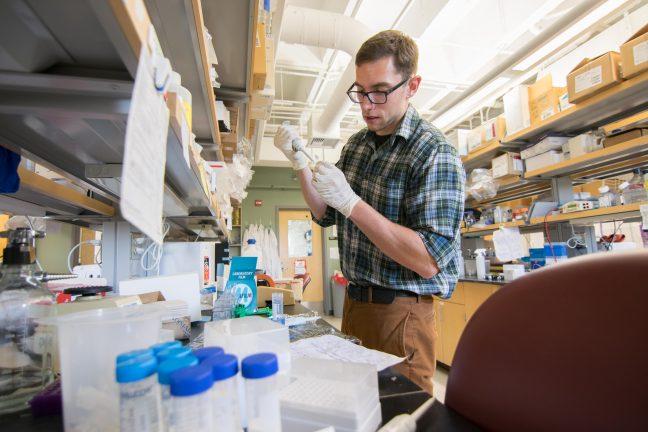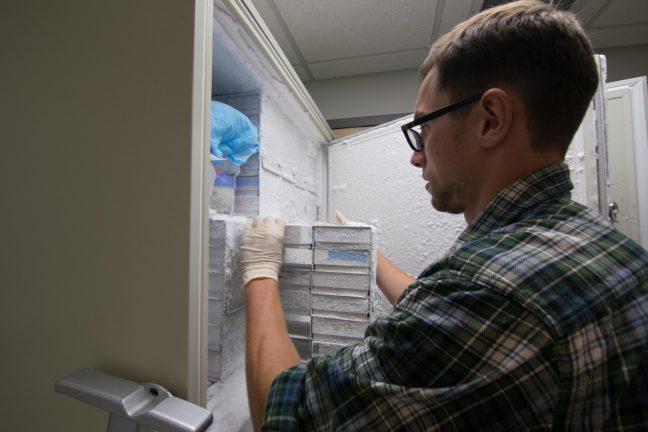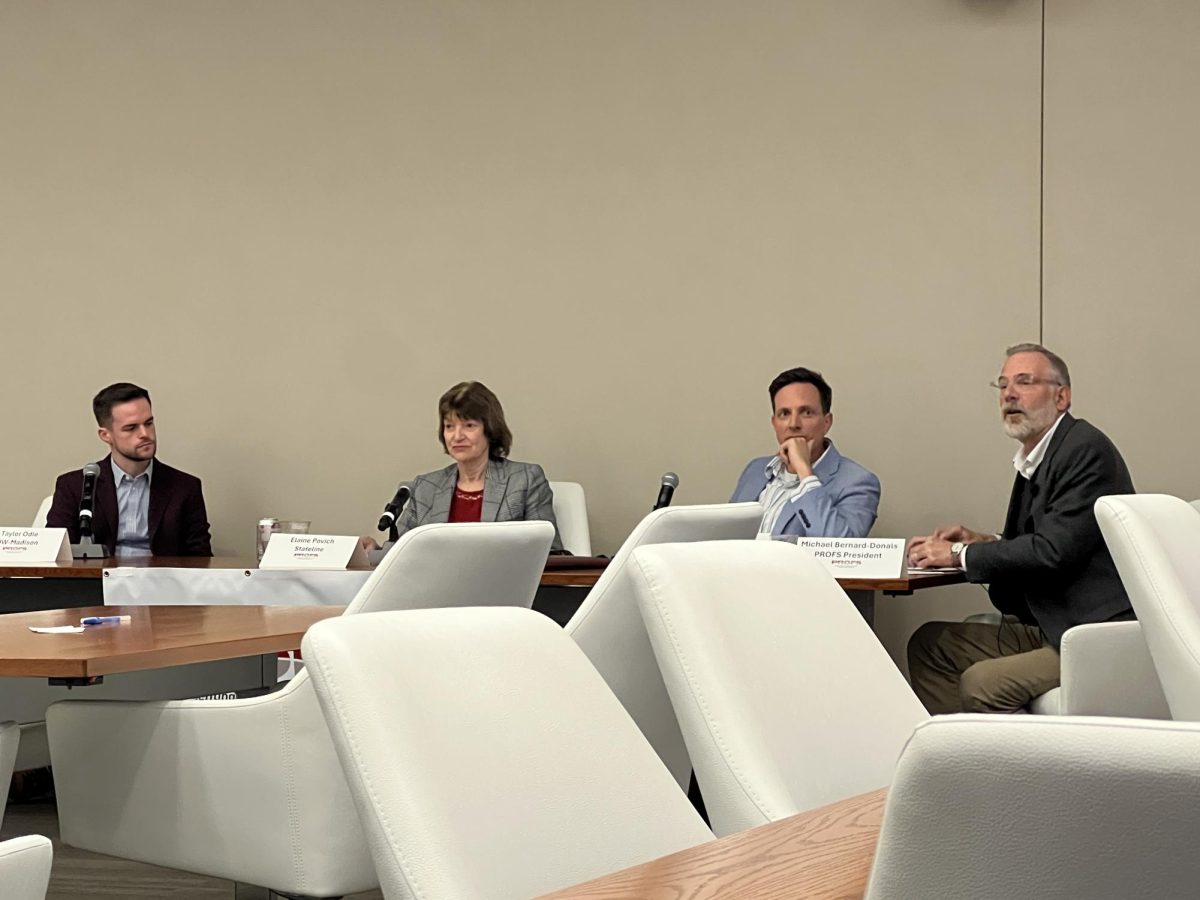Every month this semester, The Lab Report will feature a different undergraduate-research assistant on campus and their experience in the lab.
Qiang Chang Lab, Waisman Center
Senior Jared Akers gets to make art for credit, but instead of paint brushes and canvas, he uses pipettes and stem cells.
Akers is just one of the many genetics undergraduates conducting mentored research in the Waisman Center at the University of Wisconsin, with neurobiologist Dr. Qiang Chang. Chang focuses on finding a treatment for Rett Syndrome, a rare neurological disorder.
According to the National Organization of Rare Diseases, Rett Syndrome almost exclusively affects females after seven to 18 months of life. Those who are affected lose their previously acquired skills, including the ability to communicate and controllable hand movements.
Additionally, those individuals often have abnormalities such as impairment of voluntary movement, slowed head growth, breathing irregularities, feeding and swallowing complications, stunted growth, seizures and the development of distinct hand movements such as clapping or rubbing, according to NORD.
Science outreach coordinator discusses history, innovations in food crop engineering
The summer after transferring to UW from Nicolet Area Technical College in spring 2016, Akers applied to about 10 different labs, including Chang’s, taking care not to limit himself to any subject matter in particular.
“I have always wanted to go into microbial engineering and microbes,” Akers said. “But [Chang’s lab] was the opposite of what everything else in my courses would be looking at, so I wanted to do this to know what the medical side of genetics looked like — kind of get two perspectives.”

An important aspect of medical genetics involves studying the mechanism that churns the epigenetic regulation of brain functions. Epigenetics, Chang said, references the theory of nature versus nurture.
From a human biological standpoint, Chang said, everything in life is influenced by either our genes (nature) or the environment (nurture).
The interaction between these two, or the interface between our genes and the environment as Chang explained, is where epigenetics comes into play.
Chang’s lab focuses on a central epigenetic regulator, a protein called MeCP2 most commonly found in the brain, whose disruption causes Rett syndrome.
“[Epigenetic regulation] is a very important, basic mechanism for any biological system,” Chang said. “And that is dysfunctional when you don’t have MeCP2.”
Since MeCP2 is a gene found on the X chromosome, every female has two copies of the gene while every male has only one, Akers explained. Just one broken copy of MECP2 in females is enough to cause Rett syndrome.
About 95 percent of patients diagnosed with Rett syndrome carry a mutation in the MECP2 gene, Chang said.
“The genetic cause is clear, which allows us to create good genetic models of the disease,” Chang said. “[Rett syndrome] has a lot of overlapping symptoms with other neurological diseases. So hopefully we will find a treatment for Rett syndrome patients and, if we’re lucky, we may be able to help people with other diseases as well.”
Accelerator trains UW computer science students in entrepreneurship
Unlike the more familiar neurodegenerative diseases that result in death of cells, including ALS, Alzheimer’s or Parkinson’s, the affected cells in Rett syndrome patients still exist, only in a shrunken state, Chang said.
He hopes his team can ultimately find a treatment or therapy that can reverse the disease as they continue unravelling the mechanism that causes Rett syndrome, a goal that Chang believes requires the collective, knowledge-generating efforts of the whole team, even if the significance of an individual’s work may not seem that obvious.
“What we want to do, the bigger scheme, is like a forest,” Chang said. “What Jared is doing is more like he’s looking at one of the leaves on the trees. From that, you can’t see the forest, but it’s a component — it’s a piece of the puzzle… So [the students] help a lot.”
Since starting in the lab last year, Akers has mainly worked on conducting bench experiments and recording data from molecular techniques including protein extraction from cells, western blotting and immunohistochemical staining.
Western blotting is a technique that involves separating all the proteins from a tissue in a gel, then probing a specific protein in order to indicate the level of that protein expressed in the tissue, Chang said.
Immunohistochemical staining, which Akers compared to “bio art,” involves dying thin slices of brain organoids — miniature versions of the organ grown in a Petri dish — different colors, in order to see the various structures and number of cells in that organoid.
“Every time I learn a new technique, the first couple times I do it, that’s my favorite part,” Akers said. “Then I keep doing the technique for a while and it gets pretty old, but I guess there’s that sweet time when you first learn a technique and you kind of don’t know what to do. It’s fun.”

Riley Steinbrenner/The Badger Herald
Learning and mastering various molecular techniques is something Akers said he enjoys most about working in a lab setting, and believes this experience has helped him think more critically and become more detail-oriented.
Working alongside other undergraduates in the same lab has also enabled Akers to discuss approaches to complex research with his peers, which he said is reassuring as a young adult working among world-class researchers in the Waisman Center.
While Akers said he has learned a lot about the medical-side of genetics, he has become interested in the computer science aspect of it, adding that wet-lab work isn’t the “100 percent correct fit” for him.
UW scientist says ‘zero evidence’ to support link between vaccination, autism
This realization, however, is what Chang believes is a necessary part of the undergraduate research experience.
“Finding the fit is very important. Many [undergraduates] don’t realize that,” Chang said. “They just look into the lab because the professor is famous or because the disease sounds familiar.”
Chang also encouraged undergraduates to take advantage of all the opportunities on campus, and seek out labs that spark their interest, an important factor in sustaining a productive undergraduate research career, he said.
When it comes to knowing where to start, Akers suggests reaching out to professors via email, talking to senior members of academic clubs such the Society of Undergraduate Researchers or visiting department websites.
“I always thought [getting involved in undergraduate research] was disorganized, but it’s easy,” Akers said. “There’s no postings for labs of who needs undergraduates, it’s kind of just guessing and hoping that the lab that really interests you says, ‘Ok, sure.’ [Chang’s lab] was in my top five and was the one I was really hoping for.”


















